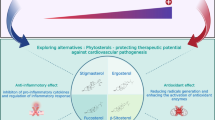Abstract
We examined the antioxidative effects of fluvastatin, a 3-hydroxy-3-methylglutaryl coenzyme A reductase inhibitor (statin), on superoxide anion formation activated by angiotensin II (Ang II) in vitro. The effects of fluvastatin were also compared to simvastatin and a water-soluble analog of α-tocopherol, trolox. Treatment of human aortic smooth muscle cells (hASMC) with Ang II for 24 hours resulted in a 3.2 ± 0.5-fold increase in intracellular superoxide anion formation as detected by lucigenin assay. hASMC treated with clinical concentrations of fluvastatin (0–100 nM) showed a dose-dependent decrease in Ang II-activated superoxide anion formation. The addition of similar concentrations of trolox to hASMC inhibited Ang II-activated superoxide anion formation in a dose-dependent manner. However, simvastatin at similar doses failed to inhibit Ang II-activated superoxide anion formation by hASMC. Our results indicate that in addition to its hypocholesterolemic effect, fluvastatin may have direct antioxidative effects, suggesting its possible protective effect on atherosclerotic process.
Similar content being viewed by others
References
Langtry HD, Markham A. Fluvastatin. Drugs 1999;57:583–606.
Rikitake Y, Kawashima S, Takeshita S, et al. Anti-oxidative properties of fluvastatin, an HMG-CoA reductase inhibitor, contribute to prevention of atherosclerosis in choresterolfed rabbits. Atherosclerosis 2001;154:87–96.
Suzumura K, Yasuhara M, Narita H. Superoxide anion scavenging properties of fluvastatin and its metabolites. Chem Pharm Bull 1999;47:1477–1480.
Suzumura K, Yasuhara M, Tanaka K, Odawara A, Narita H, Suzuki T. An in vitro study of the hydroxy radical scavenging property of fluvastatin, an HMG-CoA reductase inhibitor. Chem Pharm Bull 1999;47:1010–1012.
Suzumura K, Yasuhara M, Tanaka K, Suzuki T. Protective effect of fluvastatin sodium (xu–62–320), a 3-hydroxy-3-methylglutaryl Coenzyme A (HMG-CoA) reductase inhibitor, on oxidative modification of human low-density lipoprotein in vitro. Biochem Pharmacol 1999;57:697–703.
Nakamura T, Nishi H, Kokusenya Y, Hirota K, Miura Y. Mechanism of antioxidative activity of fluvastatindetermination of the active position. Chem Pharm Bull 2000;48:235–237.
Girona J, La Ville AE, Solà R, Plana N, Masana L. Simvastatin decreases aldehyde production derived from lipoprotein oxidation. Am J Cardiol 1999;83:846–851.
Steinberg D. Low density lipoprotein oxidation and its pathobiological significance. J Biol Chem 1997;272:20963–20966.
Berliner JA, Navab M, Fogelman AM, et al. Atherosclerosis: Basic mechanisms oxidation, inflammation, and genetics. Circulation 1995;91:2488–2496.
Witztum JL, Steinberg D. Role of oxidized low density lipoprotein in atherogenesis. J Clin Invest 1991;88:1785–1792.
Geisterfer AAT, Peach MJ, Owens GK. Angiotensin II induces hypertrophy, not hyperplasia, of cultured rat aortic smooth muscle cells. Circ Res 1988;62:749–756.
Campbell-Boswell M, Robertson Jr, AL. Effects of angiotensin II and vasopressin on human smooth muscle cells in vitro. Exp Mol Pathol 1981;35:265–276.
Daemen MJAP, Lombardi DM, Bosman FT, Schwartz SM. Angiotensin II induces smooth muscle cell proliferation in the normal and injured rat arterial wall. Circ Res 1991;68:450–456.
Griendling KK, Minieri CA, Ollerenshaw JD, Alexander RW. Angiotensin II stimulates NADH and NADPH oxidase activity in cultured vascular smooth muscle cells. Circ Res 1994;74:1141–1148.
Berry C, Hamilton CA, Brosnan MJ, et al. Investigation into the sources of superoxide in human blood vessels. Angiotensin II increases superoxide production in human internal mammary arteries. Circulation 2000;101:2206–2212.
Gyllenhammar H. Lucigenin chemiluminescence in the assessment of neutrophil superoxide production. J Immunol Methods 1987;97:209–213.
Ohara Y, Peterson TE, Harrison DG. Hypercholesterolemia increases endothelial superoxide anion production. J Clin Invest 1993;91:2546–2551.
Herd JA, Ballantyne CM, Farmer JA, et al. Effects of fluvastatin on coronary atherosclerosis in patients with mild to moderate cholesterol elevations (Lipoprotein and coronary atherosclerosis study [LCAS]). Am J Cardiol 1997;80:278–286.
Shepherd J, Cobbe SM, Ford I, et al. Prevention of coronary heart disease with pravastatin in men with hypercholesterolemia. New Eng J Med 1995;333:1301–1307.
Scandinavian Simvastatin Study Group. Randomized trial of cholesterol lowering therapy in 4444 patients with coronary heart disease: The Scandinavian Simvastatin Survival Study (4S). Lancet 1994;344:1383–1389.
Sumi D, Hayashi T, Thakur K, et al. A HMG-CoA reductase inhibitor possesses a potent anti-atherosclerotic effect other than serum lipid lowering effects—the relevance of endothelial nitric oxide synthase and superoxide anion scavenging action. Atherosclerosis 2001;155:347–357.
Hussein O, Schlezinger S, Rosenblat M, Keidar S, Aviram M. Reduced susceptibility of low density lipoprotein (LDL) to lipid peroxidation after fluvastatin therapy is associated with the hypocholesterolemic effect of the drug and its binding to the LDL. Atherosclerosis 1997;128:11–18.
Skatchkov MP, Sperling D, Ulrich H, et al. Varidation of lucigenin as a chemiluminescent probe to monitor vascular superoxide as well as basal vascular nitric oxide production. Biochem Biophys Res Commun 1999;254:319–324.
Giroux LM, Davignon J, Naruszewicz M. Simvastatin inhibits the oxidation of low-density lipoproteins by activated human monocyte-derived macrophages. Biochimica et Biophysica Acta 1993;165:335–338.
Aviram M, Dankner G, Cogan U, Hochgraf E, Brook JG. Lovastatin inhibits low-density lipoprotein oxidation and alters its fluidity and uptake by macrophages: In vitro and in vivo studies. Metabolism 1992;41:229–235.
Suzumura K, Tanaka K, Yasuhara M, Narita H. Inhibitory effects of fluvastatin and its metabolites on hydrogen peroxideinduced oxidative destruction of hemin and low-density lipoprotein. Biol Pharm Bull 2000;23:873–878.
Yamamoto A, Ichihara K, Hoshi K. Antioxidative effect of fluvastatin, an inhibitor of 3-hydroxy-3-methylglutaryl coenzyme A reductase, on peroxidation of phospholipid liposomes. J Pharm Pharmacol 2001;53:227–232.
Rao GN, Berk BC. Active oxygen species stimulate vascular smooth muscle cell growth and proto-oncogene expression. Circ Res 1992;70:593–599.
Yasuhara M, Suzumura K, Tanaka K, Takahashi M, Aoki S. Fluvastatin, an HMG-CoA reductase inhibitor, protects LDL from oxidative modification in hypercholesterolemic rabbits. Biol Pharm Bull 2000;23:570–574.
Nunes GL, Robinson K, Kalynych A, King SB III, Sgoutas DS, Berk BC. Vitamins C and E inhibit O -2 production in the pig coronary artery. Circulation 1997;96:3593–3601.
Author information
Authors and Affiliations
Rights and permissions
About this article
Cite this article
Kugi, M., Matsunaga, A., Ono, J. et al. Antioxidative Effects of Fluvastatin on Superoxide Anion Activated by Angiotensin II in Human Aortic Smooth Muscle Cells. Cardiovasc Drugs Ther 16, 203–207 (2002). https://doi.org/10.1023/A:1020692220701
Issue Date:
DOI: https://doi.org/10.1023/A:1020692220701




